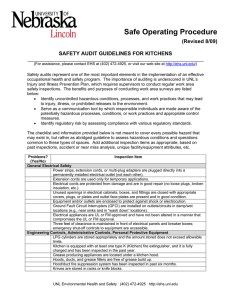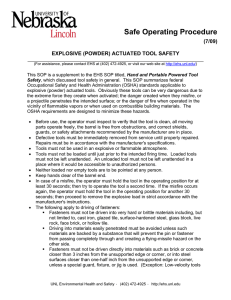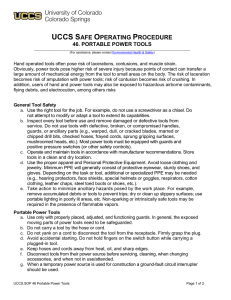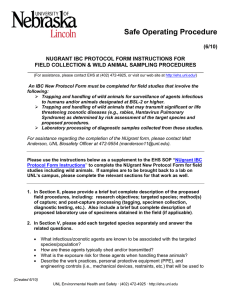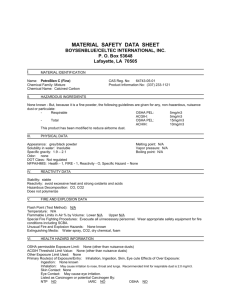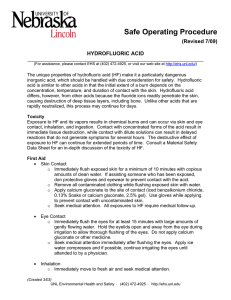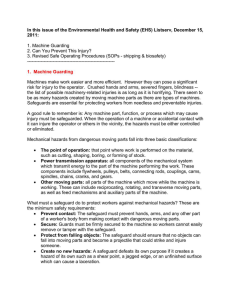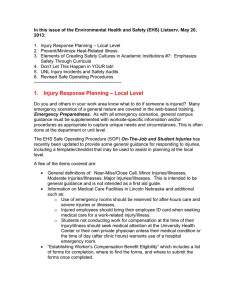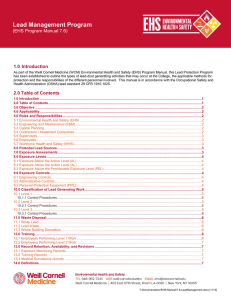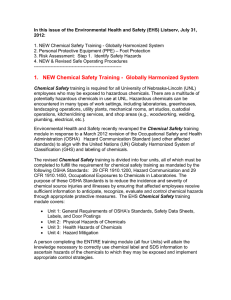Safe Operating Procedure (Revised 10/11) HAND AND PORTABLE POWER TOOL SAFETY
advertisement
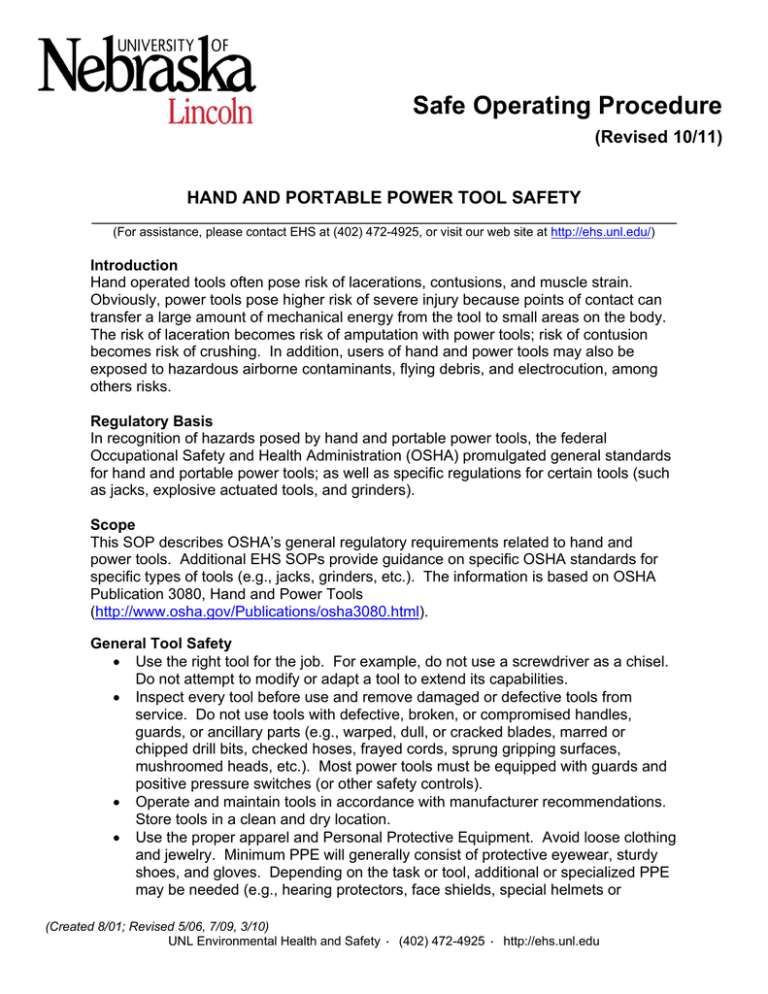
Safe Operating Procedure (Revised 10/11) HAND AND PORTABLE POWER TOOL SAFETY ______________________________________________________________________ (For assistance, please contact EHS at (402) 472-4925, or visit our web site at http://ehs.unl.edu/) Introduction Hand operated tools often pose risk of lacerations, contusions, and muscle strain. Obviously, power tools pose higher risk of severe injury because points of contact can transfer a large amount of mechanical energy from the tool to small areas on the body. The risk of laceration becomes risk of amputation with power tools; risk of contusion becomes risk of crushing. In addition, users of hand and power tools may also be exposed to hazardous airborne contaminants, flying debris, and electrocution, among others risks. Regulatory Basis In recognition of hazards posed by hand and portable power tools, the federal Occupational Safety and Health Administration (OSHA) promulgated general standards for hand and portable power tools; as well as specific regulations for certain tools (such as jacks, explosive actuated tools, and grinders). Scope This SOP describes OSHA’s general regulatory requirements related to hand and power tools. Additional EHS SOPs provide guidance on specific OSHA standards for specific types of tools (e.g., jacks, grinders, etc.). The information is based on OSHA Publication 3080, Hand and Power Tools (http://www.osha.gov/Publications/osha3080.html). General Tool Safety • Use the right tool for the job. For example, do not use a screwdriver as a chisel. Do not attempt to modify or adapt a tool to extend its capabilities. • Inspect every tool before use and remove damaged or defective tools from service. Do not use tools with defective, broken, or compromised handles, guards, or ancillary parts (e.g., warped, dull, or cracked blades, marred or chipped drill bits, checked hoses, frayed cords, sprung gripping surfaces, mushroomed heads, etc.). Most power tools must be equipped with guards and positive pressure switches (or other safety controls). • Operate and maintain tools in accordance with manufacturer recommendations. Store tools in a clean and dry location. • Use the proper apparel and Personal Protective Equipment. Avoid loose clothing and jewelry. Minimum PPE will generally consist of protective eyewear, sturdy shoes, and gloves. Depending on the task or tool, additional or specialized PPE may be needed (e.g., hearing protectors, face shields, special helmets or (Created 8/01; Revised 5/06, 7/09, 3/10) UNL Environmental Health and Safety · (402) 472-4925 · http://ehs.unl.edu • goggles, respirators, cotton clothing, leather chaps, steel toed boots or shoes, etc.). Take action to minimize ancillary hazards posed by the work place. For example, remove accumulated debris or tools to prevent trips; dry or clean up slippery surfaces; use portable lighting in poorly lit areas, etc. Non-sparking or intrinsically safe tools may be required in the presence of flammable vapors. Portable Power Tools • Use only with properly placed, adjusted, and functioning guards. In general, the exposed moving parts of power tools need to be safeguarded. • Do not carry a tool by the hose or cord. • Do not yank on a cord to disconnect the tool from the receptacle. Firmly grasp the plug. • Avoid accidental starting. Do not hold fingers on the switch button while carrying a plugged-in tool. • Keep hoses and cords away from heat, oil, and sharp edges. • Disconnect tools from their power source before servicing, cleaning, when changing accessories, and when not in use/attended. • When a temporary power source is used for construction a ground-fault circuit interrupter should be used. • To protect the user from shock and burns, electric tools must have a three-wire cord with a ground and be plugged into a grounded receptacle, be double insulated, or be powered by a low-voltage isolation transformer. • Do not use electric tools in damp or wet locations unless they are approved for that purpose. • Keep all people not involved with the work at a safe distance from the work area. • Secure work with clamps or a vise, freeing both hands to operate the tool. • When using pneumatic tools, a safety clip or retainer must be installed to prevent attachments from being ejected during tool operation. • Compressed air guns should never be pointed toward anyone. Workers should never "dead-end" them against themselves or anyone else. A chip guard must be used when compressed air is used for cleaning. • Compressed air used for cleaning. Compressed air shall not be used for cleaning purposes except where reduced to less than 30 p.s.i. and then only with effective chip guarding and personal protective equipment. • Handle, transport, and store gas or fuel only in approved flammable liquid containers, according to proper procedures for flammable liquids. Allow a hot engine to cool before refueling a tool. Use fuel-powered tools only when there is sufficient ventilation for removal of fumes. • If using nail guns, read and adhere to the content of OSHA's publication titled "Nail Gun Safety: A Guide for Construction Contractors." Exposure to dusts created by the use of tools can present respiratory hazards. Reduce dust hazards to the extent feasible by: (Created 8/01; Revised 5/06, 7/09, 3/10) UNL Environmental Health and Safety · (402) 472-4925 · http://ehs.unl.edu • • • • • • • • Utilizing local engineering controls to minimize exposures, including enclosures, tools equipped with dust collection devices, and local ventilation/dust collection systems, and maintain these systems so that they function effectively. Avoid dry sweeping of dusts. Use a vacuum system or wet method. Do not use compressed air to clean dusty surfaces. Avoid inadvertent transport of dusts on equipment or work pieces. Clean them before they are removed from the work area. Keep the general work area clean of dust accumulations. Contact EHS if you conduct dust-generating activities without the benefit of engineering controls so that an exposure evaluation can be completed to assess the need for respiratory protection. Do not eat or drink in work areas. Use protective outer garments to avoid contaminating clothing and transporting dusts out of the work area. Eye protection is also required when conducting work that could result in creation of flying debris or dust. Wash hands and exposed skin thoroughly after conducting dust producing operations. (Created 8/01; Revised 5/06, 7/09, 3/10) UNL Environmental Health and Safety · (402) 472-4925 · http://ehs.unl.edu

